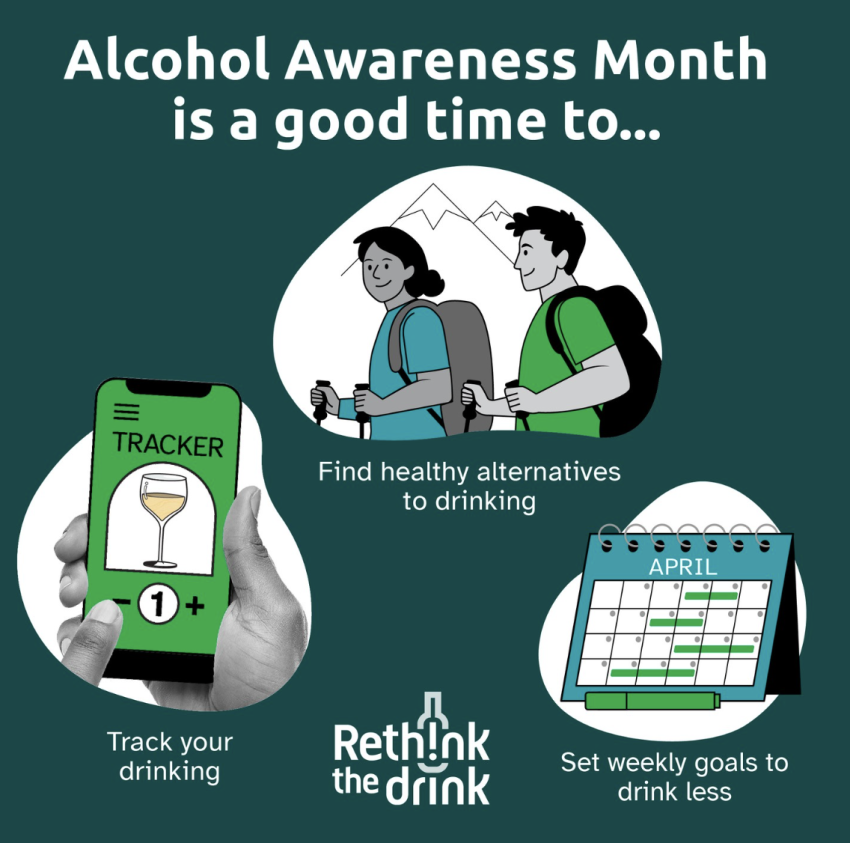April marks Alcohol Awareness Month, a time to educate ourselves and our communities about the risks of alcohol misuse and its widespread impact on health and well-being. It is important for people to fully understand the risks of alcohol so that they can make informed decisions about whether to drink.
OHA’s Rethink the Drink Campaign
Alcohol remains a major public health concern both nationally and here in Oregon. In fact, excessive alcohol use is the third leading cause of preventable death among Oregonians, according to the Oregon Health Authority (OHA). Nationwide, alcohol is associated with over 178,000 deaths each year, and is linked to more than 200 diseases and injury-related conditions. To raise awareness and offer practical tools for change, the OHA’s Rethink the Drink campaign continues to empower Oregonians with information, self-assessment tools, and treatment resources. Rethink the Drink is not trying to convince everyone to stop drinking altogether, but to rethink how alcohol has become so commonplace in our daily lives. From the RtD website: “‘Rethink the Drink’ is not a code phrase for ‘stop drinking.’ (Although we do offer resources to help you drink less). We’re simply asking people in Oregon to pause for a moment and consider the role of alcohol in our own lives and communities. Could we handle our alcohol in healthier ways?”


You can explore the campaign further at www.rethinkthedrink.com.
Top Takeaways from Rethink the Drink:
• More than 1 in 5 Oregon adults drink excessively, and most of them do not have alcohol use disorder—suggesting that harmful drinking habits are more common than many realize.
• Excessive drinking includes binge drinking, heavy drinking, underage drinking, and drinking while pregnant.
• We generally recognize the health risks that come with heavy drinking, but even lowlevel drinking, as little as one drink a day, can increase the risk of cancer.
● Binge drinking = 5+ drinks for men, 4+ drinks for women on one occasion.
● Heavy drinking = 15+ drinks/week for men, 8+ drinks/week for women. (These definitions come from the CDC and are consistent year to year.)
● Alcohol misuse increases the risk of several cancers—including breast, colorectal, liver, and cancers of the head and neck—as well as heart disease and liver disease.
● Not all drinks contain the same amount of alcohol. Alcohol calculators can help a person understand how many standard drinks that are in each drink.
For more information about standard drinks, visit https://www.rethinkthedrink.com/ the “Rethink the Drink” site also encourages users to adopt the Track, Count, and Shift approach:
1. Track your drinking habits.
2. Count how much alcohol is in each drink.
3. Shift toward healthier choices and seek support when needed.
For people who feel that they need support to reduce excessive alcohol use, help is available. Visit https://www.rethinkthedrink.com/ or for local support, contact Tillamook Family Counseling Center for more information by calling (503)842-8201.
Start the Conversation—Especially with Youth
Adults play a crucial role in shaping youth attitudes toward alcohol. Young people are more likely to engage in risky drinking behaviors if the adults around them model excessive drinking. Here are some practical tips from the National Institutes of Health, https://www.niaaa.nih.gov/, for talking with youth about alcohol:
● Begin these conversations early and keep them going through adolescence and early adulthood
● Integrate alcohol-related topics into everyday conversations.
● Ask questions and practice active listening.
● Set and explain clear family expectations around alcohol.
● Educate youth on the health consequences of alcohol use.
● Emphasize that underage drinking is a form of excessive drinking, and that it can increase the risk of developing AUD later in life.
● Help youth practice refusal skills—develop a few strategies together for saying no in real-life situations.
Additional online resources from the National Institutes of Health (NIH) for talking with youth about alcohol:
● Facts About Teen Drinking: Designed for teens, this website contains in-depth information about how alcohol affects health, how to identify signs of an alcohol problem, and how to get help. niaaaforteens.niaaa.nih.gov/
● NIAAA for Middle School: This web resource contains interactive activities to help parents, caregivers, and teachers introduce and reinforce key messages about peer pressure, resistance skills, and other important topics related to underage drinking. www.niaaa.nih.gov/alcohols-effects-health/niaaa-middle-school
● Alcohol and Your Brain: A Virtual Reality Experience: This educational experience shares age-appropriate messages through engaging visuals, informative billboards, and narration. www.niaaa.nih.gov/alcohol-and-your-brain-virtual-reality-experience-0
Remember that help is available, whether you’re concerned about your own drinking, supporting a loved one, or trying to raise awareness in your community. Reach out to Tillamook Family Counseling Center at (503) 842-8201 to learn about how we can support you.


